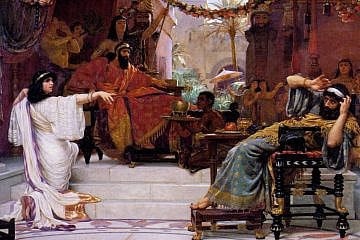We are in pain, but we need to see the positive in our situation. We need to give thanks for those doing good.
Leiah Elbaum
(JNS)
One book that has made a deep impression on me is Esh Kodesh, written in secret in the Warsaw Ghetto by Rabbi Kalonimus Kalman Szapiro, the Piaseczno Rebbe, and buried in milk churns underneath the ghetto. Rabbi Szapiro was murdered by the Nazis in November 1943, but his writings were discovered after the war and published by his surviving students.
Among his teachings, I have always been guided by the principle that in the depth of despair and tragedy, one should seek out the person who needs help. Even in the darkest hour, find ways to do chesed, acts of lovingkindness. Turn the paralysis of grief and trauma into the positive of helping someone else, even if it might be your final act.
This was also the lesson of Rabbi Szapiro’s own life. At a time when it seemed as though the Jewish people had no future and were doomed to be wiped out, he continued to live and work as though tomorrow would always come.
The very act of preserving testimonies and burying them was an act of hope that there would be survivors to find these hidden writings, and that the remnant of the Jewish people would be restored.
Which brings me to Purim.
It’s hard to think about celebrating any festival in Israel’s current situation, let alone the raucous, joyous, silly season of Purim with its dressing up and feasting.
Months of war, hostages in Gaza, vast numbers of bereaved families, thousands of war wounded, an entire nation still deep in trauma and grief since Oct. 7. Really, who has the stomach now for parties, clowns and making merry?
And yet, this is precisely Purim. Purim isn’t “Carnival.” It isn’t a celebration for celebration’s sake but a Jewish holiday commemorating our deliverance from annihilation. Haman the Amalekite had convinced the drinking and carousing Persian emperor to let him kill all the Jewish people in Shushan—effectively, the entire Jewish nation at the time. Purim, despite being clothed in fun and silliness, is a story of Jews successfully defending themselves against enemies set on their genocide.
The ensuing celebration is not an easy one. Mordechai and Esther instruct the Jewish people how to observe this festival of Thanksgiving: In “the month that turned from grief to joy, from mourning to a holiday, to commemorate them as days of feasting and joy, giving food gifts to friends, and gifts to the poor.”
It is one thing to breathe a sigh of relief at being saved from destruction and another to actively celebrate that deliverance. A traumatized, exhausted people who have just fought against murderous mobs can’t necessarily see the broad historical perspective.
Mordechai and Esther had the vision to know how to mark the occasion. The enormity of these events needed to be remembered throughout the generations—to serve as a source of eternal faith that whatever dire straits the Jewish people might face, the tables could be turned.
To my mind, they were also looking to heal the deeply scarred and traumatized Jewish people. The merriment—the emphasis on the topsy-turvy turn of events—could help the Jews release some of their pain and grief by focusing on celebrating life, on finding a way to be joyful and thankful despite the horrors.
Their instructions to hold joyful feasts recall the lavish parties of the decadent Persian emperor. Yet unlike the emperor’s long extravaganzas of drinking, the celebrations Esther and Mordechai describe are fixed in scope. They set a specific time for a persecuted people to release their stresses, not license to engage in over-the-top parties and weeks of reckless abandon.
Yet for many, it did not feel like a time for celebration. So they established that Purim must also involve reaching out to all sectors of the community with gifts of food and donations to the needy. The entire community was saved in those miraculous days. The entire community needed to be included in giving thanks for that miracle.
This is an essential lesson of Purim for our difficult times. We are in pain, but we need to also see the positive in our situation. We need to give thanks for those doing good, to recognize the helpers and the successes, even as we mourn our terrible losses and do all we can to bring home our long-suffering hostages.
Purim isn’t about the dress-up, the drinking or the joking around. It’s an appreciation of the gift that the great power of the day permitted the Jewish people to defend themselves in the face of a genocidal plot. That is surely a message that resonates with the Jewish experience through the centuries.
Those who don’t feel like gathering with friends and family—for whom Oct. 7 is still too raw for even a modest celebration—can focus on the mitzvot of the day that involves helping others.
Bring joy to children who are evacuees from frontline communities in Israel’s north or south. Visit hospitals or run Purim activities at a local retirement home, or offer to read the Megillah for those who are housebound.
Make a modest Purim seudah (“feast”) and invite a new family in your congregation, or a recently divorced or widowed friend, or some elderly neighbors. There are so many who need this kind of “hug,” not just now, but especially now.
Mishloah manot isn’t about themed baskets or baking marathons. It’s about seeing others in our community: a neighbor we aren’t so close to but who is going through crisis, a miluim (“reservist”) family or a socially awkward kid in your child’s class, an old friend you’ve lost touch with or a relative who needs a boost. Even in our communities which are full of kindness and love, too many people can be “transparent.” Mishloah manot is an opportunity to help them feel seen.
Mordechai and Esther—and the Piaseczno Rebbe—shared the same perspective. In the face of tragedy, take your grief, your trauma, your despair, and turn it towards chesed and mitzvot, kindness and compassion.
Image: “Esther Denouncing Haman,” oil on canvas, by Ernest Normand, 1888. Credit: Wikimedia Commons



